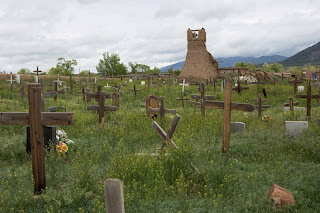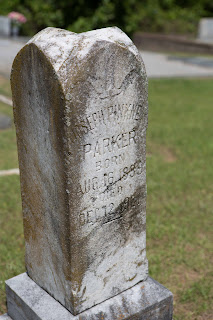I've found that one can learn a lot about the history of an area in its cemeteries and you can also find some of the area's best art and architecture there. Monuments are often in the form of statuary that rivals that of the local art museum and the poetry from tombstones can be quite remarkable.
Graves of the famous and notorious become tourist attractions and objects of veneration. I've visited the graves of JFK in Arlington, Virginia, Marie Laveau in New Orleans, tried to visit famous railroad-engineer Casey Jones' grave in Jackson, Tennessee but the cemetery was locked, Meriwether Lewis's grave on the Natchez Trace Parkway and the grave of Joe Cain in Mobile, Alabama. The infamous Boot Hill in Dodge City, Kansas is now a major tourist attraction.
A cemetery on the edge of Taos Pueblo in New Mexico surrounds a long-destroyed church dating to the 16th century. The cemetery is no longer accepting new burials as it is full.
 |
| Cemetery at Taos Pueblo, New Mexico |
I've visited a cemetery in northwest Alabama, the only creatures buried there are coondogs that have been certified, in writing by three witnesses, to have treed a raccoon without assistance from another dog. There are dogs brought there from all over the country, their monuments ranging from simple wooden crosses to elaborate inscribed marble.
I've visited the grave of the only man in America to create a monument to the assassin John Wilkes Booth. Joseph Pinkney Parker, a Confederate Veteran of the War Between the States, hated Abraham Lincoln so much that when Lincoln was assassinated, Parker had a monument created and engraved: "Erected by Pink Parker in honor of John Wilkes Booth for killing Old Abe Lincoln." Parker, a resident of Troy, Alabama, tried to have the monument erected in the county courthouse square to no avail. He placed the monument in his yard where it stood for several years. It received national attention with demands that it be destroyed. Parker died before the furor did. His family had the monument re-engraved with Parker's name and dates and stands today as his headstone, sans his tribute to Boothe.
 |
| Tombstone of Joseph Pinkney "Pink" Parker, Troy, Alabama |
Exploration of a cemetery leads to finds of tombstones bearing inscriptions telling the stories of lives cut way too short, children victims of epidemics from bygone eras or of entire families consumed by disease or tragedy. Headstones tell love stories between couples and between parents and their children. Honors received and achievements grace some epitaphs. Then there are the newer cemeteries where no headstones or grave slabs are allowed except for markers, identical to all the rest, with only the name, birth and death dates inscribed.
Cemeteries tell of our society. We are buried with "our people." There are cemeteries for Catholics, for Jews, for members of the church where the cemetery is located. The Bonaventure Cemetery in Savannah, Georgia has an area for burial of retired railroad conductors. Mobile's Magnolia Cemetery has sections dedicated to various fraternal organizations as well as an area for Confederate soldiers.
There are cemeteries for our veterans with the monuments laid out with military precision reminding one of formations on the parade grounds with soldiers, sailors, airmen and marines marching to a common cadence.
 |
| Veterans Cemetery at Magnolia Cemetery, Mobile, Alabama |
A google search reveals that the largest US cemetery is Calvary Cemetery, a Roman Catholic cemetery, located in the Queens portion of New York City, with over 3 million burials. Contrast that to family burial sites with as few as one burial.
Theologian, professor, pastor, Dr. WC Dobbs, Sr. grew up in the southwest Oklahoma towns of Altus and Blair. After many years of living and working in various parts of the country, he longed to be buried on the family farm located just outside Blair. A small family cemetery was created and Dr. Dobbs was buried there following his death in 2007.
His son, musician and minister WC Dobbs, Jr., who was also my sister's husband, expressed his desire to be returned to that cemetery. Following a life of service to God, his family and to churches and people around the southeast US, WC died in 2012. But he continued to serve following his death when his body was donated to the University of South Alabama's College of Medicine through the Anatomical Gift Program. Medical students use the donated bodies to study anatomy and gain knowledge and insight of the human body. His remains were then cremated and returned to the family.
So on a Sunday in late May, 2015, WC Jr. returned to Oklahoma where his family held a brief service then spread his ashes on the family cemetery. Although he's not buried there, he is there as is his headstone.
I started writing this by saying that every trip I take ends up in a cemetery and I guess, for most of us, the long trip through life ends that way too! I'll follow WC's lead and donate my body to science and where my ashes end up, it really doesn't matter. Maybe these writings will be my epitaph. "
